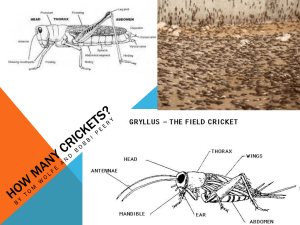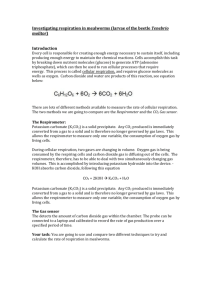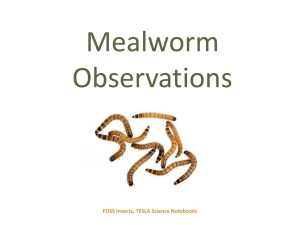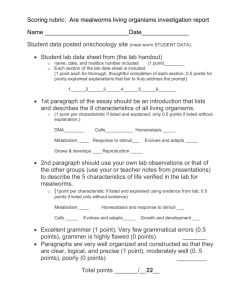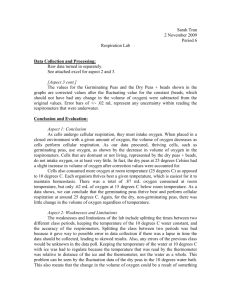Pre-AP Biology Cellular Respiration Lab.doc
advertisement
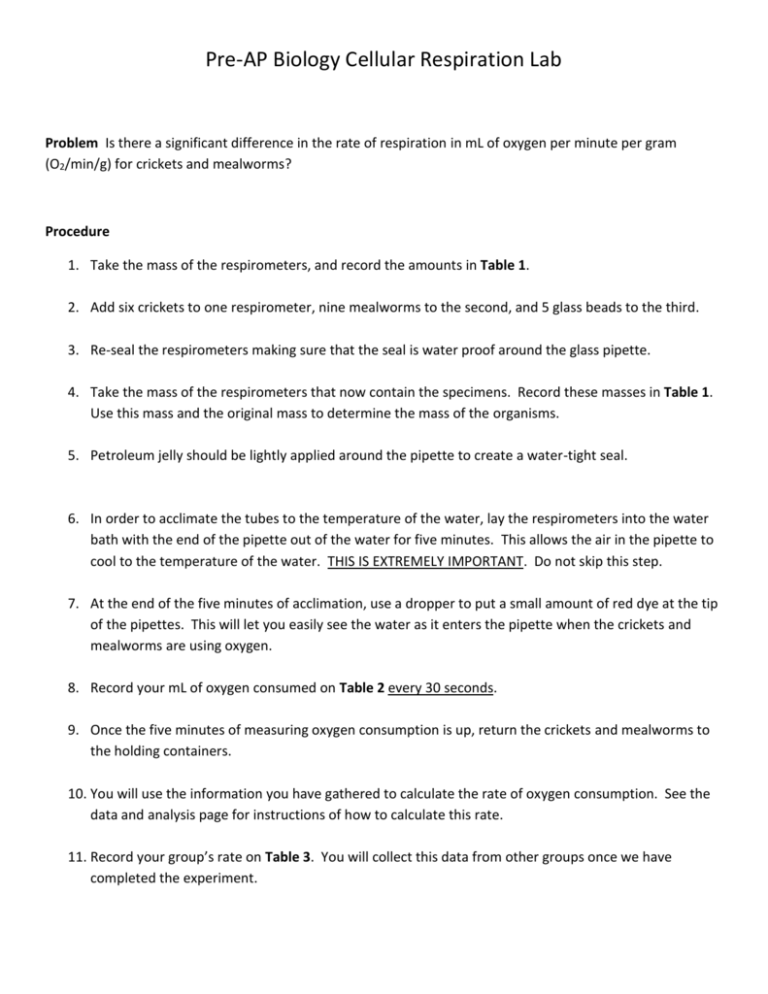
Pre-AP Biology Cellular Respiration Lab Problem Is there a significant difference in the rate of respiration in mL of oxygen per minute per gram (O2/min/g) for crickets and mealworms? Procedure 1. Take the mass of the respirometers, and record the amounts in Table 1. 2. Add six crickets to one respirometer, nine mealworms to the second, and 5 glass beads to the third. 3. Re-seal the respirometers making sure that the seal is water proof around the glass pipette. 4. Take the mass of the respirometers that now contain the specimens. Record these masses in Table 1. Use this mass and the original mass to determine the mass of the organisms. 5. Petroleum jelly should be lightly applied around the pipette to create a water-tight seal. 6. In order to acclimate the tubes to the temperature of the water, lay the respirometers into the water bath with the end of the pipette out of the water for five minutes. This allows the air in the pipette to cool to the temperature of the water. THIS IS EXTREMELY IMPORTANT. Do not skip this step. 7. At the end of the five minutes of acclimation, use a dropper to put a small amount of red dye at the tip of the pipettes. This will let you easily see the water as it enters the pipette when the crickets and mealworms are using oxygen. 8. Record your mL of oxygen consumed on Table 2 every 30 seconds. 9. Once the five minutes of measuring oxygen consumption is up, return the crickets and mealworms to the holding containers. 10. You will use the information you have gathered to calculate the rate of oxygen consumption. See the data and analysis page for instructions of how to calculate this rate. 11. Record your group’s rate on Table 3. You will collect this data from other groups once we have completed the experiment. Respirometer Assembly Data and Analysis Table 1: Mass of Apparatus Mass of Apparatus +Organism Mass of Organism Cricket Apparatus Mealworm Apparatus Beads Apparatus Table 2: Time (Min:Sec) 0:00 0:30 1:00 1:30 2:00 2:30 3:00 3:30 4:00 4:30 5:00 Oxygen Consumed (mL) Crickets Oxygen Consumed (mL) Mealworms 0:00 0:30 1:00 1:30 2:00 2:30 3:00 3:30 4:00 4:30 5:00 Total Oxygen Consumed over five minutes (mL) Crickets: Mealworms: Change in Volume (mL) Glass Beads 0:00 0:30 1:00 1:30 2:00 2:30 3:00 3:30 4:00 4:30 5:00 Glass Beads: Total Oxygen Consumed per minute: (mL) (5 minute total/5) Crickets: Mealworms: Glass Beads: Rate of Respiration: (mL O2/min/g) Crickets: Mealworms: mL O2/min/gram = Table 3: Group 1 2 3 4 Glass Beads: mL O2/min Mass in grams Respiration Rate of Crickets Respiration Rate of Mealworms Write the appropriate chemical equations: Photosynthesis: _________________________________________________________________ Cellular Respiration: _________________________________________________________________ Analysis Questions: 1. Does there seem to be a difference between the rates of respiration of the two organisms? Explain. __________________________________________________________________________________ __________________________________________________________________________________ 2. How is studying cellular respiration related to our previous study of photosynthesis and energy in ecosystem food chains? __________________________________________________________________________________ __________________________________________________________________________________ __________________________________________________________________________________ __________________________________________________________________________________ __________________________________________________________________________________ 3. How does our study of photosynthesis and cellular respiration relate to the interdependence observed between organisms in nature? __________________________________________________________________________________ __________________________________________________________________________________ __________________________________________________________________________________ __________________________________________________________________________________ __________________________________________________________________________________ 4. In this experiment, why was it necessary to first remove CO2 with the KOH before the consumption of O2 was measured? __________________________________________________________________________________ __________________________________________________________________________________ __________________________________________________________________________________ __________________________________________________________________________________ __________________________________________________________________________________ 5. When a predator consumes its prey, it does so partly for the need of energy. We studied how electrons are used at the end of the electron transport chain of respiration to make large amounts of ATP. Because these electrons are used to make something that all organisms use for life processes, how could you explain in your own words where these electrons originated and how they were made available in a form useful to living things? __________________________________________________________________________________ __________________________________________________________________________________ __________________________________________________________________________________ __________________________________________________________________________________ __________________________________________________________________________________

